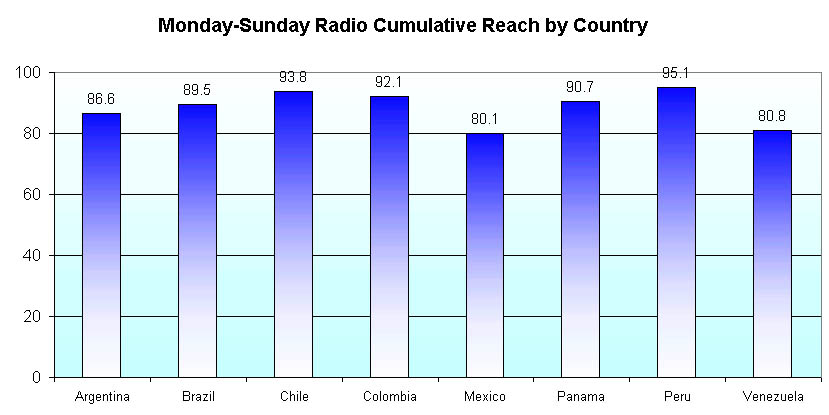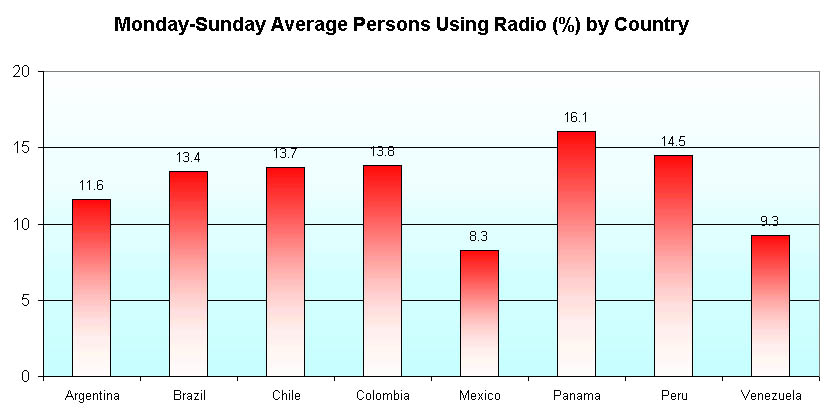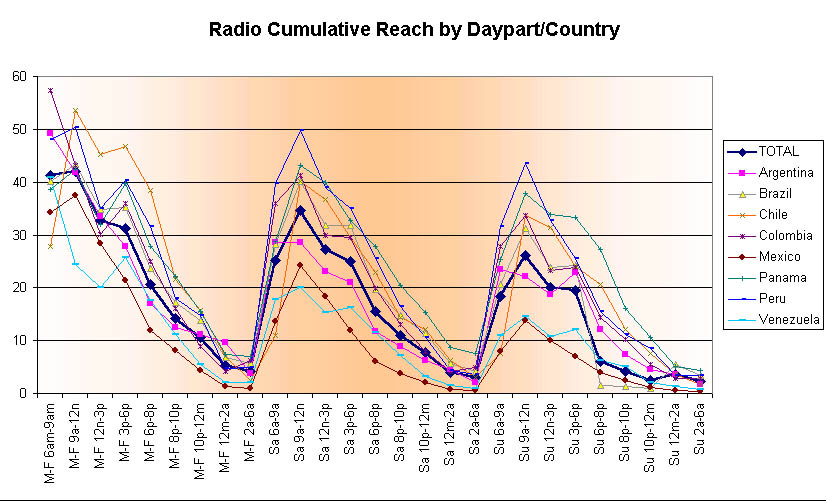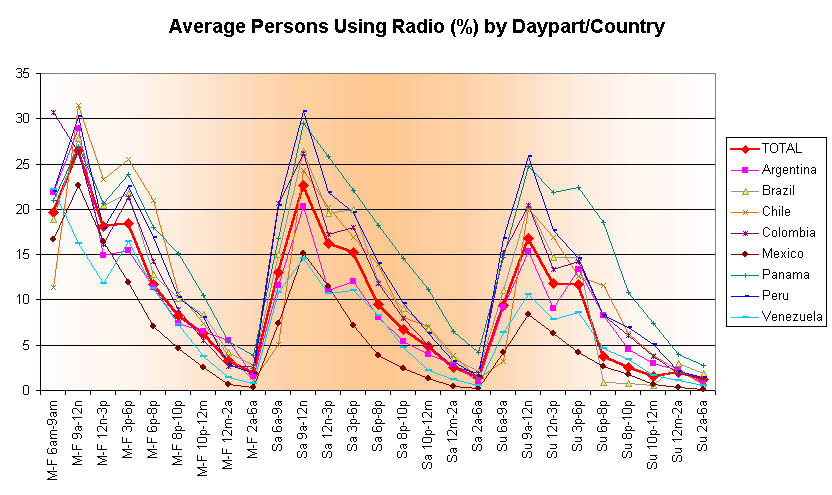
(source: TGI Latina)
International Comparisons of Radio Usage
Radio is the first electronic media to achieve mass distribution. Compared to television and now the Internet, radio is considered an old medium. Yet, it did not come into existence until the early twentieth century, and it took some years before it achieved nearly universal penetration. Today, nearly every household in Latin America has a radio reception device of some form, whether they are pure radio devices (which can vary in size from a crystal radio set to a portable radio to a large vacuum tube device) or composite equipment (such as a clock radio or a Walkman/Discman radio or a portable cassette player-radio 'boom' box or a floor-model stereo system). In addition, radio is also present in many places, such as barber shops, hairdressing salons, bars, restaurants, waiting areas, buses, etc.
We will now cite some survey data from the TGI Latina study. This is a survey of more than 50,000 persons between the ages of 12 to 64 years old in eight different countries (Argentina, Brazil, Chile, Colombia, Mexico, Panama, Peru and Venezuela) conducted during 2001 and 2002. Within the TGI Latina study, there are a number of questions about radio usage, dealing with daypart usage, format types and individual radio stations. We will be concerned with overall and daypart usage in this article.
Overall, during a typical seven-day week, 86.6% of the survey respondents indicated that they listen to radio for some time. Traditionally, this measure is known as the cumulative weekly reach for the radio medium. At this high level, radio has nearly universal reach. The drawback to the cumulative measure is that it makes no distinction between those who listen to radio for five minutes a week from those who listen to more than 100 hours of radio per week. To consider the volumetric aspects, we have another standard audience measure --- the average percent of persons using radio (PUR) --- which can be interpreted in two ways. In the first instance, at a typical moment during the week, we say that 11.6% of the population is listening to some form of radio. Alternately, we also say that the average persons spends 11.6% of their time listening to radio (and they may be doing something else at the same time).
The title of this article indicates that we are interest in international comparisons. The next two charts show the cumulative weekly reach and the average persons using radio by the eight Latin American countries. There are some noticeable differences, especially with Mexico having slightly lower numbers than the other countries. There is no intrinsic reason as to why radio ought to have a certain reach or average audience. Rather, the present state is a function of many factors --- the historical development of the radio industry in a country, the attractiveness of radio content, the role that radio plays in the cultural life, the habits of the population in terms of leisure activities, the importance of radio as a source of information, the travel patterns of the population, the social and family lives of people, and so on.

(source: TGI Latina)

(source: TGI Latina)
As with any other medium, the usage of radio is uneven across the times of day. In the simplest example, most people sleep at night; while they may fall asleep while the radio is on and then wake up to the sound of radio on the alarm clock, those sleeping hours are not considered media usage. In the next two charts, we show the two radio audience measures by various parts of the day during weekdays, Saturdays and Sundays. These patterns make a contrast with television, because the 'prime time' for radio is in the morning on weekdays whereas the 'prime time' for television is in the evening across the entire week. Radio is different because it is audio-only and therefore listening is often done in conjunction with other activities (such as getting dressed, driving to work, and so on). We also observed that on weekend mornings, people do not need to wake up as early so that early morning daypart (6am-9am) is not as highly rated as late morning.

(source: TGI Latina)

(source: TGI Latina)
Given that our interest is in international comparisons, we will present the daypart numbers separately by country in the following. Due to the large number of lines in the charts, we have also provided the numbers in tabular form. This would give the careful reader a chance to contemplate the details. The overall patterns are fairly consistent across countries, and the same types of patterns are seen in many other places of the world. But there are some significant differences in details. For example, if we look at weekday early morning (6am-9am) and weekday late morning (9am-12n), we see that Chileans are latter radio users compared to the earlier radio users in Colombia and Venezuela. This is yet another example of global trends with local differences.
| Cumulative Reach |
TOTAL | Argentina | Brazil | Chile | Colombia | Mexico | Panama | Peru | Venezuela |
| M-F 6am-9am | 41.3 | 49.1 | 40.1 | 27.9 | 57.3 | 34.2 | 38.6 | 48.0 | 40.9 |
| M-F 9a-12n | 41.9 | 41.9 | 43.4 | 53.5 | 43.1 | 37.4 | 42.3 | 50.4 | 24.3 |
| M-F 12n-3p | 32.7 | 33.5 | 34.8 | 45.3 | 30.2 | 28.4 | 32.0 | 35.1 | 20.1 |
| M-F 3p-6p | 31.2 | 27.8 | 35.1 | 46.7 | 36.0 | 21.4 | 39.7 | 40.3 | 25.8 |
| M-F 6p-8p | 20.6 | 17.1 | 23.7 | 38.5 | 25.0 | 12.0 | 27.8 | 31.7 | 17.5 |
| M-F 8p-10p | 14.3 | 12.6 | 17.1 | 21.5 | 16.1 | 8.2 | 22.2 | 18.1 | 11.2 |
| M-F 10p-12m | 10.6 | 11.1 | 13.8 | 15.6 | 9.0 | 4.4 | 15.5 | 14.8 | 5.5 |
| M-F 12m-2a | 5.4 | 9.6 | 6.8 | 7.0 | 4.1 | 1.2 | 7.4 | 4.7 | 2.2 |
| M-F 2a-6a | 4.1 | 3.7 | 5.7 | 2.5 | 6.3 | 1.0 | 7.0 | 4.9 | 2.0 |
| Sa 6a-9a | 25.1 | 28.5 | 28.3 | 11.0 | 36.0 | 13.7 | 28.7 | 39.8 | 17.8 |
| Sa 9a-12n | 34.7 | 28.6 | 40.1 | 40.2 | 41.3 | 24.2 | 43.2 | 49.8 | 20.1 |
| Sa 12n-3p | 27.3 | 23.1 | 31.9 | 36.8 | 30.0 | 18.3 | 39.9 | 39.0 | 15.3 |
| Sa 3p-6p | 24.9 | 20.9 | 31.8 | 29.5 | 29.6 | 12.0 | 32.8 | 34.9 | 16.2 |
| Sa 6p-8p | 15.4 | 11.8 | 19.7 | 22.8 | 20.0 | 6.0 | 27.8 | 25.5 | 11.5 |
| Sa 8p-10p | 11.0 | 8.9 | 14.7 | 14.4 | 13.0 | 3.9 | 20.5 | 16.4 | 7.2 |
| Sa 10p-12m | 7.9 | 6.3 | 11.3 | 12.2 | 7.9 | 2.0 | 15.3 | 10.6 | 3.2 |
| Sa 12m-2a | 4.0 | 4.6 | 5.6 | 6.3 | 4.2 | 0.7 | 8.6 | 4.4 | 1.5 |
| Sa 2a-6a | 3.0 | 2.2 | 4.2 | 3.0 | 5.0 | 0.5 | 7.6 | 3.6 | 1.0 |
| Su 6a-9a | 18.4 | 23.5 | 20.6 | 7.6 | 27.8 | 8.0 | 25.4 | 31.5 | 11.0 |
| Su 9a-12n | 26.2 | 22.2 | 31.2 | 33.7 | 33.6 | 13.8 | 37.8 | 43.5 | 14.6 |
| Su 12n-3p | 20.1 | 18.6 | 23.9 | 31.4 | 23.2 | 10.1 | 33.9 | 32.7 | 10.7 |
| Su 3p-6p | 19.5 | 22.9 | 24.2 | 24.1 | 23.8 | 7.0 | 33.3 | 25.6 | 12.1 |
| Su 6p-8p | 6.1 | 12.2 | 1.5 | 20.6 | 14.4 | 3.9 | 27.2 | 15.6 | 6.3 |
| Su 8p-10p | 4.1 | 7.4 | 1.3 | 12.1 | 10.2 | 2.5 | 16.0 | 11.2 | 5.1 |
| Su 10p-12m | 2.4 | 4.4 | 0.9 | 7.6 | 5.6 | 1.1 | 10.7 | 8.5 | 2.1 |
| Su 12m-2a | 3.5 | 3.7 | 5.5 | 3.6 | 2.9 | 0.5 | 5.1 | 3.3 | 1.4 |
| Su 2a-6a | 2.3 | 1.6 | 3.5 | 1.7 | 2.9 | 0.4 | 4.3 | 3.3 | 0.8 |

(source: TGI Latina)
| Persons
Using Radio |
TOTAL | Argentina | Brazil | Chile | Colombia | Mexico | Panama | Peru | Venezuela |
| M-F 6am-9am | 19.7 | 21.9 | 18.8 | 11.4 | 30.7 | 16.6 | 21.0 | 21.9 | 22.2 |
| M-F 9a-12n | 26.5 | 28.9 | 27.8 | 31.5 | 26.2 | 22.6 | 27.0 | 30.2 | 16.2 |
| M-F 12n-3p | 18.2 | 14.9 | 20.5 | 23.3 | 16.1 | 16.4 | 20.7 | 17.9 | 11.9 |
| M-F 3p-6p | 18.4 | 15.5 | 21.7 | 25.5 | 21.3 | 11.9 | 23.9 | 22.6 | 16.4 |
| M-F 6p-8p | 11.7 | 11.4 | 12.8 | 21.0 | 14.2 | 7.1 | 18.0 | 16.9 | 11.3 |
| M-F 8p-10p | 8.3 | 7.4 | 10.1 | 10.7 | 8.9 | 4.6 | 15.1 | 10.3 | 7.3 |
| M-F 10p-12m | 6.3 | 6.5 | 8.4 | 7.4 | 5.6 | 2.5 | 10.5 | 8.0 | 3.8 |
| M-F 12m-2a | 3.3 | 5.6 | 4.2 | 3.9 | 2.6 | 0.7 | 5.4 | 2.9 | 1.5 |
| M-F 2a-6a | 1.9 | 1.6 | 2.8 | 1.1 | 2.6 | 0.4 | 3.9 | 1.9 | 0.8 |
| Sa 6a-9a | 13.0 | 11.6 | 15.1 | 5.0 | 20.7 | 7.4 | 16.8 | 20.4 | 10.9 |
| Sa 9a-12n | 22.7 | 20.3 | 26.4 | 24.2 | 26.2 | 15.2 | 29.5 | 30.9 | 14.6 |
| Sa 12n-3p | 16.2 | 11.1 | 19.5 | 20.2 | 17.2 | 11.5 | 25.8 | 21.8 | 10.7 |
| Sa 3p-6p | 15.3 | 12.0 | 20.0 | 16.9 | 17.9 | 7.2 | 22.1 | 19.7 | 11.1 |
| Sa 6p-8p | 9.5 | 8.1 | 12.0 | 13.9 | 11.8 | 3.8 | 18.2 | 14.0 | 8.3 |
| Sa 8p-10p | 6.8 | 5.5 | 9.0 | 8.0 | 7.9 | 2.5 | 14.6 | 9.6 | 4.8 |
| Sa 10p-12m | 4.8 | 4.0 | 6.8 | 7.1 | 5.0 | 1.3 | 11.1 | 6.3 | 2.2 |
| Sa 12m-2a | 2.6 | 2.8 | 3.6 | 3.9 | 2.6 | 0.5 | 6.5 | 3.2 | 1.2 |
| Sa 2a-6a | 1.4 | 1.0 | 2.1 | 1.3 | 1.9 | 0.2 | 4.2 | 1.6 | 0.6 |
| Su 6a-9a | 9.4 | 9.2 | 11.0 | 3.2 | 15.2 | 4.2 | 14.7 | 16.8 | 6.4 |
| Su 9a-12n | 16.8 | 15.4 | 20.4 | 20.0 | 20.5 | 8.4 | 24.7 | 25.9 | 10.6 |
| Su 12n-3p | 11.8 | 9.1 | 14.7 | 16.8 | 13.4 | 6.3 | 21.9 | 17.6 | 7.8 |
| Su 3p-6p | 11.7 | 13.4 | 14.7 | 12.6 | 14.2 | 4.2 | 22.4 | 14.6 | 8.6 |
| Su 6p-8p | 3.8 | 8.3 | 0.9 | 11.6 | 8.2 | 2.6 | 18.5 | 8.3 | 4.7 |
| Su 8p-10p | 2.6 | 4.5 | 0.8 | 6.3 | 6.1 | 1.8 | 10.8 | 6.9 | 3.4 |
| Su 10p-12m | 1.6 | 3.0 | 0.6 | 3.9 | 3.7 | 0.7 | 7.4 | 5.0 | 1.6 |
| Su 12m-2a | 2.0 | 2.2 | 3.0 | 2.2 | 1.9 | 0.3 | 3.9 | 2.1 | 1.1 |
| Su 2a-6a | 1.2 | 0.8 | 1.8 | 0.7 | 1.3 | 0.2 | 2.8 | 1.4 | 0.5 |

(source: TGI Latina)
(posted by Roland Soong, 11/12/2002)
(Return to Zona Latina's Home Page)